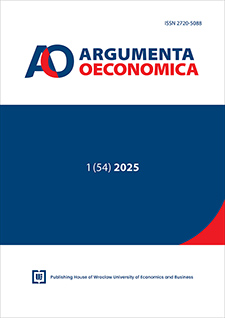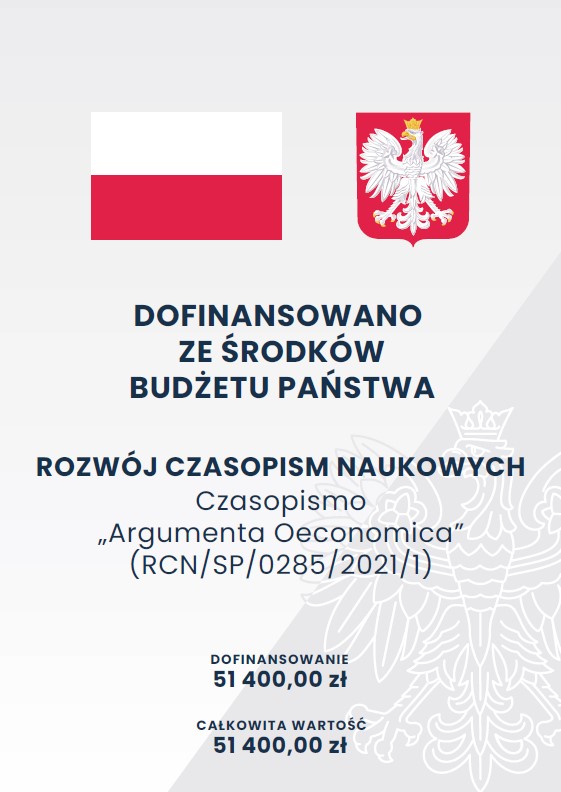An empirical analysis of the impact of institutions on economic growth: Evidence from Latin American countries
DOI:
https://doi.org/10.15611/aoe.2025.1.08Keywords:
institutions, economic growth, dynamic panel model, Latin AmericaAbstract
Aim: The aim of this article was to assess the impact of institutions on economic performance, using Latin American countries in the period of 1996-2021 as a case study.
Methodology: Data for this study were obtained from the World Bank and United Nations Development Programme. In this study, the measures proposed by Kaufmann and Kraay were employed. The study’s time frame spanned the period 1996 to 2021. The geographical scope included 21 Latin American economies. Dynamic panel models were employed.
Results: The results revealed that institutions play a fundamental role in driving economic growth. The establishment of a proper set of institutions is essential for a country to escape from the poverty trap. Despite Latin American countries sharing similarities in terms of language, religion, and historical colonisation by European countries, they demonstrate significant economic disparities. For instance, Chile and Uruguay were able to successfully implement reform measures that set them on a path of economic growth.
Implications and recommendations: To achieve a high rate of economic growth, it is crucial to establish a suitable institutional framework. This leads to the conclusion that institutions serve as the primary driver of economic growth.
Originality/value: The problem of the impact of institutions on economic growth is discussed in the literature and has been the subject of empirical research. In this article, the empirical verification was carried out on the basis of Latin American countries, which is the originality of this study. In this way, it was confirmed on a new dataset that institutions do matter. On the other hand, it should be noted that Latin American countries, considered similar, are not so similar.
Downloads
References
Abera, F., Mulugeta, W., & Melaku, T. (2019). Impact of institutional quality on economic performance of Eastern Africa: A panel data analysis. Jurnal Perspektif Pembiayaan Dan Pembangunan Daerah, 7(2), 169-182. https://doi.org/10.22437/ppd.v7i2.7863
Acemoglu, D. (2007). Introduction do Modern Economic Growth. Princeton University Press.
Acemoglu, D., & Robinson, A. J. (2012). Why Nations Fail: The Origins of Power, Prosperity, and Poverty. Profile Books.
Acemoglu, D., & Robinson, A. J. (2020). The Narrow Corridor. States, Societes,and the Fate of Liberty. Penguin LCC US.
Arellano, M., & Bond, S. (1991). Some Tests of Specification for Panel Data: Monte Carlo Evidence and an Application to Employment Equation. The Review of Economic Studies, 2(58)), 277-297. https://doi.org/10.2307/2297968
Arellano, M., & Bover, O. (1995). Another look at the instrumental variable estimation of error-components models. Journal of Econometrics, 1(68), 29-51. https://doi.org/10.1016/0304-4076(94)01642-D
Aron, J. (2000). Growth and Institutions: A Review of the Evidence. The World Bank Research Observer, 1(15), 99-135.
Baltagi, B. H. (2005). Econometric Analysis of Panel Data. Springer.
Blundell, R., & Bond, S. (1998). Initial conditions and moment restrictions in dynamic panel data models. Journal of Econometrics, 1(87), 115-143. https://doi.org/10.1016/S0304-4076(98)00009-8
Clark, G. (2014). The Industrial Revolution. In P. Aghion, & S. N. Durlauf (Eds.) Handbook of Economic Growth (pp. 217-262). Elsevier.
Coatsworth, J. H. (2005). Structures, endowments, and institutions in the economic history of Latin America. Latin America Research Review, 40(3), 126-144. https://doi.org/10.1353/lar.2005.004
Epaphra, M., & Kombe, A. H. (2017). Institutions and economic growth in Africa: Evidence from panel estimation. Research in Agricultural & Applied Economics, 13(5), 570-590. https://doi.org/10.22004/ag.econ.285110
Glaeser, E. L., La Porta, R., Lopez-de-Silanes, F., & Shleifer, A. (2004). Do institutuions cause Growth? Journal of Economic
Growth, 9(3), 271-303. Hasan, R., Mitra, D., & Ulubasoglu, M. (2006). Institutions and policies for growth and poverty reduction: The role of private sector development. Asian Development Review, 24(1), 69-116.
Harriss, J., Hunter, J., & Lewis, C. M. (1995). Introduction. Development and significance of NIE. In J. Harris, J. Hunter, & C. M. Lewis (Eds.), The New Institutional Econocmis and Third World Development. Routledge.
Iheonu, C., Ihedimma, G., & Onwuanaku, C. (2017). Institutional Quality and Economic Performance in West Africa. MPRA Paper 82212.
Kaufmann, D., Kraay, A., & Mastruzzi, M. (2010). The Worldwide Governance Indicators: Methodology and Analytical Issues. World Bank Policy Research Working Paper, 5440.
Kaufmann, D., Kraay, A., & Mastruzzi, M. (2011). The Worldwide Governance Indicators: Methodology and Analytical Issues. Hague J Rule Law,3, 220-246. https://link.springer.com/article/10.1017/S1876404511200046
Keefer, P., & Knack, S. (1995). Institutions and economic performance: Cross-country tests using alternative institutional measures. Economics & Politics, 7(3), 207-227.
Mauro, P. (1995). Corruption and growth. Quartely Journal of Economics, 3110, 681-712.
Nawaz, S., Iqbal, N., & Khan, M. A. (2014). The impact of institutional quality on economic growth: Panel evidence. The Pakistan Development Review, 53(1), 15-31.
Nguyen, C., Su, T., & Nguyen, T. (2018). Institutional quality and economic growth: The case of emerging economies. Theoretical Economics Letters, 8, 1943-1956, https://doi.org/10.4236/tel.2018.811127
North, D. C. (1990). Institutions, Institutional Change and Economic Performance. Cambridge University Press.
North, D. C. (1994). Economic performance through time. The American Economic Review, 3(84), 359-368.
North, D. C. (2003). The New Institutional Economics and Third World Development. In W J. Harris, J. Hunter, & C. M. Lewis (Eds.), The New Institutional Econocmis and Third World Development. Routledge.
Rodrik, D. (2000). Institutions for high-quality growth: What they are and how to acquire them. Studies in Comparative International Development, 35(3), 3-31.
Rodrik, D. (2007). One Economics. Many Recipes. Globalization, Institutions, and Economic Growth. Princeton University Press.
Rodrik, D., Subramianian, A., & Trebbi, F. (2004). Institutions Rule: The Primacy of Institutions over Geography and Integration in Economic Development. Journal of Economic Growth, 9, 131-165.
Sala-i-Martin, X. (2002). 15 years of new growth economics: What we have learnt? Working Papers Central Bank of Chile, 172, Central Bank of Chile. https://ideas.repec.org/p/chb/bcchwp/172.html
Sari, V. K., & Prastyani, D. (2021). The impact of the institution on economic growth: An evidence from ASEAN. Jurnal Ekonomi Pembangunan, 19(1), 17-26. https://media.neliti.com/media/publications/455519-the-impact-of-the-institution-oneconomi-886e56d8.pdf
Scully, G. W. (1988). The institutional framework and economic development. Journal of Political Economy, 3(96), 652-662.
Siyakiya, P. (2017). The impact of Institutional quality on economic performance: An empirical study of European Union 28 and prospective Member Countries. World Journal of Applied Economics, 3(2), 3-24.
Smith, A. (1776). An Inquiry into the Nature and Causes of the Wealth of Nations. University of Chicago Press.
Tran, O., Le, H., & Nguyen, A. (2021). Role of institutional quality in economic development: A case study of Asian countries. Problems and Perspectives in Management, 2(19), 357-369. http://dx.doi.org/10.21511/ppm.19(2).2021.29
Vianna, A., & Mollick, A. (2018). Institutions: Key variable for economic development in Latin America. Journal of Economics and Business, 96, 42-58. https://doi.org/10.1016/j.jeconbus.2017.12.002
Vijayaraghavan, M., & Ward, W. A. (2001). Institutions and economic growth: Empirical evidence for a cross-national analysis. Research in Agricultural & Applied Economics. https://doi.org/10.22004/ag.econ.112952
World Bank (n.d.). https://www.worldbank.org
Yildrim, A., & Gökalp, M. F. (2016). Institutions and economic performance: A review on the developing countries. Procedia Economics and Finance, 38, 347-359. https://doi.org/10.1016/S2212-5671(16)30207-6
Downloads
Published
License
Copyright (c) 2025 Łukasz Topolewski

This work is licensed under a Creative Commons Attribution-ShareAlike 4.0 International License.
Accepted 2024-06-20
Published 2025-03-25








